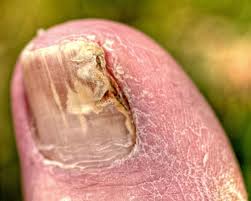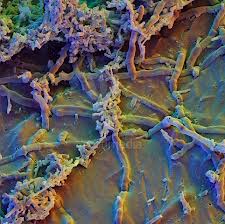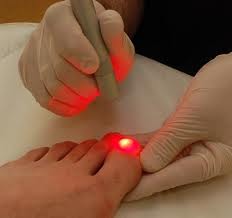Conveniently located to serve Newnan, Peachtree City and LaGrange
Click here to jump to:
Newnan Nail Fungus (Onychomycosis)
WHAT IS NAIL FUNGUS?
Nail fungus is also referred to medically as onychomycosis. This is the most common nail disease and represents half of all nail disorders. Toenails are afflicted with nail fungus more often than fingernails. It affects just under 10 percent of the adult population.

WHAT ARE THE MAJOR TYPES OF NAIL FUNGUS?

There are four major types of nail fungus. These can be classified into the following four categories. They include:
- DISTAL SUBUNGAL ONYCHOMYCOSIS– is the most common form of nail fungus, and is usually caused by the orgainism Trichophyton rubrum, which invades the nail bed and the underside of the nail plate
- WHITE SUPERFICIAL ONYCHOMYCOSIS (WSO)-is a fungal invasion of the superficial layers of the nail plate and resembles “white islands” on the plate. It accounts for 10 percent cases. Some cases are misdiagnosed and are not true fungus but a reaction to nail polish that can cause the nails to have a chalky white appearance. A laboratory test should be performed to confirm the diagnosis.
- PROXIMAL SUBUNGAL ONYCHOMYCOSIS– is fungal penetration of the newly formed nail plate through the proximal nail fold. It is the least common form of nail fungus in healthy people.
- CANDIDIAL INFECTION– is Candida species invasion of the fingernails, usually occurring in persons who frequently immerse their hands in water. This normally requires the prior damage of the nail by infection or trauma. Diabetics are also prone to this type of nail fungus.
WHAT ARE THE SYMPTOMS OF NAIL FUNGUS?
The most common symptom is a thickened and discolored (white, black, yellow or green) nail. As the infection progresses the nail can become brittle and they can split easily. If left untreated, the skin can become inflamed and painful underneath and around the nail. There also may be white or yellow patches on the nail bed or scaly skin next to the nail. There is usually no pain or other bodily symptoms, unless the disease is severe.People with nail fungus can experience anxiety due to the appearance of the nail, particularly when fingernails are affected.
Related
Content
Patient
Review
“There were no issues and everyone was very professional and attentive. Thank you!”
by Anonymous
HOW IS NAIL FUNGUS TREATED?
Common treatments using revolve around systemic or topical antifungal medications. These include medications such as clotrimazole, terbinafine or itraconazole. There is evidence that combining systemic and topical treatments is beneficial.
For superficial white onychomycosis, systemic rather than topical antifungal therapy is recommended.
LASER HEAT

Research suggests that fungi are sensitive to heat, typically 40-60°C. The basis of laser treatment is to try heat the nail bed to these temperatures in order to disrupt nail fungal growth. Laser is a somewhat new approach to treating nail fungus. Although it show a trend towards treatment benefit, those test studies which have been carried out with laser have been carried out on small sample sizes. More clinical trials are therefore needed.
We look forward to helping you and are happy to answer any questions that you may have about nail fungus. Remember to follow through with your prescribed treatment to achieve optimal results. If you would like to schedule an appointment with us, click here.











